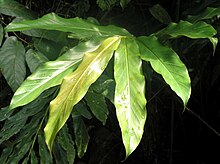| Etlingera maingayi | |
|---|---|

| |
| Pandan | |
| Scientific classification | |
| Kingdom: | Plantae |
| Clade: | Tracheophytes |
| Clade: | Angiosperms |
| Clade: | Monocots |
| Clade: | Commelinids |
| Order: | Zingiberales |
| Family: | Zingiberaceae |
| Genus: | Etlingera |
| Species: | E. maingayi
|
| Binomial name | |
| Etlingera maingayi | |
| Synonyms[2] | |
| |
Etlingera maingayi, the Malay rose, is a species of herbaceous, perennial, flowering plant in the ginger family, Zingiberaceae.[2][3][4] This species occurs in southern Thailand, where its flowers are eaten as vegetables, and Malaysia.[5] It grows along forest edges and in disturbed areas.[4]
Description[edit]
Etlingera maingayi grows to less than 2 m (6 ft 7 in) high.[6] Its leaves are variable, with undulating fringes, and emit a sour scent when crushed.[7] Young leaves are translucent and reddish on both sides.[5]
Chemistry[edit]
Leaves of E. maingayi displayed ferrous ion chelating ability and lipid peroxidation inhibition activity that were much higher than young leaves of Camellia sinensis.[7] Leaves of E. maingayi had the highest yield of oil (1320 mg/100 g) consisting mainly of lauric acid (45%) and decanoic acid (43%). The unpleasant sour scent of leaves when crushed may be due to these two acids.
References[edit]
- ^ Saw, L.G. (2019). "Etlingera maingayi". IUCN Red List of Threatened Species. 2019: e.T117321504A124282222. doi:10.2305/IUCN.UK.2019-3.RLTS.T117321504A124282222.en. Retrieved July 26, 2020.
- ^ a b "Etlingera maingayi (Baker) R.M.Sm". Plants of the World Online. The Trustees of the Royal Botanic Gardens, Kew. n.d. Retrieved July 26, 2020.
- ^ "Etlingera maingayi". toptropicals.com. Retrieved 2010-02-08.
- ^ a b Yeats, Helen (29 October 2013). "The History and Cultivation of Etlingera – The Torch Gingers – at the Royal Botanic Garden Edinburgh". Sibbaldia: The International Journal of Botanic Garden Horticulture (11): 71–85. doi:10.24823/Sibbaldia.2013.52.
- ^ a b "Thai Zingiberaceae: Species diversity and their uses". International Union of Pure and Applied Chemistry. Retrieved 2010-02-08.
- ^ Lim, C. K. (2000). "Taxonomic notes on Etlingera Giseke (Zingiberaceae) in Peninsular Malaysia: the Nicolaia taxa". Folia Malaysiana. 1: 1–12.
- ^ a b Chan, E.; Lim, Y.; Omar, M. (2007). "Antioxidant and antibacterial activity of leaves of Etlingera species (Zingiberaceae) in Peninsular Malaysia". Food Chemistry. 104 (4): 1586–1593. doi:10.1016/j.foodchem.2007.03.023.
